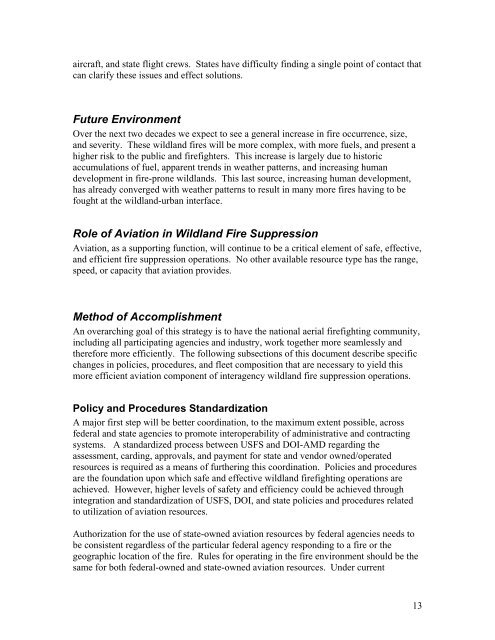Interagency Aviation Strategy - July 2008 - National Wildfire ...
Interagency Aviation Strategy - July 2008 - National Wildfire ...
Interagency Aviation Strategy - July 2008 - National Wildfire ...
Create successful ePaper yourself
Turn your PDF publications into a flip-book with our unique Google optimized e-Paper software.
aircraft, and state flight crews. States have difficulty finding a single point of contact that<br />
can clarify these issues and effect solutions.<br />
Future Environment<br />
Over the next two decades we expect to see a general increase in fire occurrence, size,<br />
and severity. These wildland fires will be more complex, with more fuels, and present a<br />
higher risk to the public and firefighters. This increase is largely due to historic<br />
accumulations of fuel, apparent trends in weather patterns, and increasing human<br />
development in fire-prone wildlands. This last source, increasing human development,<br />
has already converged with weather patterns to result in many more fires having to be<br />
fought at the wildland-urban interface.<br />
Role of <strong>Aviation</strong> in Wildland Fire Suppression<br />
<strong>Aviation</strong>, as a supporting function, will continue to be a critical element of safe, effective,<br />
and efficient fire suppression operations. No other available resource type has the range,<br />
speed, or capacity that aviation provides.<br />
Method of Accomplishment<br />
An overarching goal of this strategy is to have the national aerial firefighting community,<br />
including all participating agencies and industry, work together more seamlessly and<br />
therefore more efficiently. The following subsections of this document describe specific<br />
changes in policies, procedures, and fleet composition that are necessary to yield this<br />
more efficient aviation component of interagency wildland fire suppression operations.<br />
Policy and Procedures Standardization<br />
A major first step will be better coordination, to the maximum extent possible, across<br />
federal and state agencies to promote interoperability of administrative and contracting<br />
systems. A standardized process between USFS and DOI-AMD regarding the<br />
assessment, carding, approvals, and payment for state and vendor owned/operated<br />
resources is required as a means of furthering this coordination. Policies and procedures<br />
are the foundation upon which safe and effective wildland firefighting operations are<br />
achieved. However, higher levels of safety and efficiency could be achieved through<br />
integration and standardization of USFS, DOI, and state policies and procedures related<br />
to utilization of aviation resources.<br />
Authorization for the use of state-owned aviation resources by federal agencies needs to<br />
be consistent regardless of the particular federal agency responding to a fire or the<br />
geographic location of the fire. Rules for operating in the fire environment should be the<br />
same for both federal-owned and state-owned aviation resources. Under current<br />
13
















